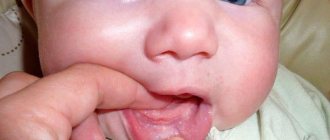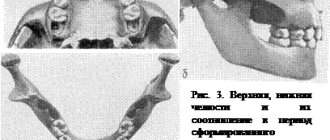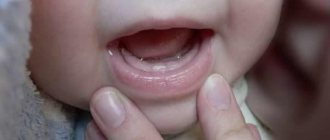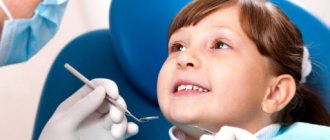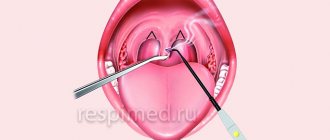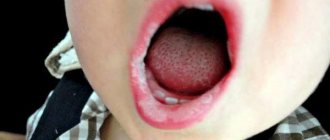The order of eruption of baby teeth
Everyone is different, but it is still important to know how most babies develop. Children's first teeth usually erupt almost simultaneously on the right and left. The sequence is as follows: first the anterior ones (incisors, canines), then the posterior ones.
It is important to understand that this pattern of teething in children is average, and in your case it may happen in a different order or at a different time. This does not necessarily indicate any violations.
Doctors have compiled an approximate, average diagram of teething in children:
Don't worry if you don't meet these standards for several months. If the parents got teeth late, most likely the children will have the same. Heredity has a very strong influence on development. The teething pattern should not become an unnecessary source of parental anxiety. This is just a guideline, like all other norms.
Both the sequence and timing of teething in children can vary greatly. Only if you are “late” by more than 6 months (for example, nothing appears until a year), it is worth discussing this with your doctor. There are genetic disorders when the rudiments of teeth do not develop at all. However, this is extremely rare. Some diseases also affect the timing of teething, but these conditions in children always manifest themselves with some more obvious symptoms.
In any case, there is no remedy that would “cut teeth” - we won’t pull them out of the jaw. We also do not regulate the cutting order. All that remains is to observe the process in children and take care of their health in general.
Teeth are cutting!
A seven-month-old child has a fever, his nose is running, he refuses to eat... Is it really ARVI again? After all, you just recently got sick? Or maybe the child isn’t sick after all? But then where do these symptoms, typical of colds, come from?
You can read about the symptoms of ARVI in children here
Today, with Valeria Aleksandrovna Golovko, a pediatrician at Clinic Expert Tula LLC, we are talking about long-awaited teeth. How many months does the first tooth appear? What accompanies their appearance? Our article is about this and much more.
- The first thing parents expect from a child is a smile, then his “aha”, but the most exciting expectation is whether the baby will have teeth? When do babies' first teeth start to grow?
According to statistics, the first milk teeth appear on average at 6-8 months of age. As a rule, these are the middle lower incisors.
The onset of teething depends on a number of factors. From which ones exactly?
— heredity or, in other words, the timing of the appearance of teeth in the baby’s parents;
- full-term baby. Premature babies may develop teeth later;
- the child’s nutrition, namely, sufficient intake of calcium into the body (after the start of complementary feeding, the main sources of calcium are cottage cheese and somewhat less - kefir);
— sufficient intake of vitamin D into the body. Its natural sources are egg yolk and butter;
— climatic conditions. Children living in hot climates erupt teeth earlier;
- gender of the child. Girls erupt teeth earlier;
- sometimes a deviation in the period of teeth appearance from the statistical average in one direction or another occurs in situations where a baby has 1-2 teeth immediately after birth. They are usually always defective and quickly fall out or are removed.
- What is the pattern of baby teeth eruption in children?
First, the lower middle incisors appear (simultaneously or in turn). Then 4 upper incisors erupt, and then 2 lower lateral ones. On average, a baby has 8 teeth by the age of one year.
After this, the molars (premolar teeth) are cut. The lower anteriors appear somewhat earlier (at 12-18 months), and the upper anteriors appear later (at 13-19 months).
Then the rear molars appear: the lower ones - from 20 to 31 months, and the upper ones - from 16 to 22 months.
Canines: lower - from 16 to 23 months, and upper - from 16 to 22 months.
Those. By the age of 3, a child has 20 primary teeth, i.e. incisors, canines and molars.
Individual differences should also be kept in mind, i.e. this number of teeth can be at 2 or 2.5 years.
- Let's talk about the first signs of teeth appearing in a baby. What could they be?
One of the first manifestations is redness and swelling of the gums. Salivation increases. Appetite worsens, up to complete refusal to eat. Irritability increases and sleep is disturbed. The baby asks to be held more often, and physical activity increases. The reason is itching and sore gums.
- What painful symptoms can accompany the appearance of teeth in a child?
This is salivation, nasal congestion and discharge from it. Sometimes there is a cough/cough, stool disturbances in the form of loosening (but maintaining the normal frequency of bowel movements). There may be irritation of the skin of the mouth, chin, chest, i.e. areas where saliva enters. In some cases, the temperature rises: more often not higher than 38.5°C, less often - 39°C and higher, often subsides on the second or third day. The child may become irritable.
Vomiting and diarrhea are less common: in this case, you need to be especially vigilant, since these signs may not be associated with teeth, but indicate some kind of disease - for example, rotavirus infection.
What to do if your child has a stomach ache? The story is told by the surgeon, Deputy Chief Physician for Pediatrics at Clinic Expert Smolensk LLC Alexey Alexandrovich Zakharov
- How to relieve baby's teething pain?
This task is not easy. First of all, it is necessary to ensure that the baby has the opportunity to chew sufficiently. This is what teethers are designed for. Massaging your gums may help.
Gels are also used when teething in children, but their disadvantage is that they can cause an allergic reaction.
There are homeopathic rectal suppositories. According to indications, antipyretic and analgesic syrups can be used.
-Which teethers are best to use?
They must be elastic and durable (and therefore safe). The best ones are silicone, latex, having the appropriate anatomical shape to form the correct bite.
There are also plastic teethers that contain liquid or gel inside. Before use, they are cooled in the refrigerator (at +6°C) and only then given to the child. The additional cold factor also reduces pain to a certain extent. The downside is that these teethers need to be constantly cooled.
A separate advantage of teethers is their positive effect on fine motor skills.
-Can I use carrots, apples or cookies instead of teethers?
In principle, it is possible, but, firstly, these products should already be in the child’s diet; secondly, their use should not begin when the first teeth erupt: at least, all incisors should be present; and thirdly, the child must be able to swallow food well. If you give a teething child an apple, carrot or cookie, you must ensure that the child does not choke.
- How do you feel about using traditional methods to help a child who is teething?
Overall positive, however, only after consulting a doctor. Why? Sometimes, for example, when teething, herbal decoctions are used, but at the same time, one should remember the possibility of allergic reactions.
Is your child suffering from allergies? Ulyana Vladimirovna Chemova, an allergist-immunologist at Clinic Expert Smolensk, tells how to help a baby.
In particular, a decoction of chamomile flowers and a ready-made high-quality aqueous solution of propolis are used.
- Are the first teeth and their appearance a reason to contact a pediatrician or should you go to see him only if something worries you?
Sometimes, under the “mask” of teething, the onset of an infectious disease can be hidden. Therefore, if two or more of the signs that I mentioned earlier are detected, you need to contact your pediatrician.
You can make an appointment with a pediatrician in your city here
- Does teething always affect the general condition of the baby? Or can teeth appear easily and without parents even noticing?
No, the general condition does not always change. In some cases, parents find out about an erupted tooth by catching it with a spoon when feeding the child.
- What is the most important thing when teething? How can parents and their children survive this period calmly?
A universal remedy - double parental affection, attention and care for the baby. Don’t be afraid to pamper your child, carry him in your arms more - this will add calmness to the baby and create a sense of security.
It should be remembered that this period is not very long and, like everything, it too will pass and will later be remembered with a smile.
- The anxiety is over, the first teeth have appeared. How to properly care for them?
As soon as the first tooth appears, you can visit the dentist and begin oral care. There are special silicone brush attachments (put on your finger) that can be used to treat the teeth of even a 6-month-old child. This should be done at least once a day until the age of one year. From the age of one, you can brush your teeth with a very soft toothbrush, moving from the gums to the cutting edge of the tooth or chewing surface.
You might be interested in:
What will help with a cough: badger fat or mustard in socks? We treat children correctly
Your immune system is under control! We create a strong rear for the child
Are unvaccinated children the healthiest?
For reference:
Golovko Valeria Alexandrovna
Graduate of the Faculty of Medicine of Tula State University in 2004.
In 2005, she completed an internship in the specialty “Pediatrics”
Currently working as a pediatrician at Clinic Expert Tula LLC.
What problems may arise during teething in infants?
Difficulties do not always arise. But sometimes, about 3 days before and 3 days after teething, the baby’s condition changes:
- gums swell;
- saliva flows more strongly (although a lot of it can be released without connection with teething);
- the temperature rises slightly;
- mood deteriorates (child is less active, cries more often);
- sleep becomes restless;
- stools become slightly looser and more frequent;
- your cheeks turn slightly red (no need to immediately look for allergens and change your diet).
These symptoms may not all appear, in any combination.
The difficulty is that the same symptoms, but usually stronger, can also occur in children with infections. Therefore, if your condition has changed significantly, consult your doctor.
Red flags (tell your doctor if your child has):
- temperature above 38 degrees in the absence of cold symptoms;
- a rash that is unfamiliar to you, which appeared along with a high fever;
- diarrhea, vomiting;
- lethargy;
- mouth ulcers or other sores.
- Eruption cyst (hematoma).
Assess how much the child's condition has changed. If he begins to clearly feel unwell, there is no need to attribute this to the teething of baby teeth. In this case, you need a doctor to rule out more serious problems.
How does teething occur?
In most cases, in children everything goes according to the plan provided by nature: incisors - premolars - canines - molars. At the age of 4 to 8 months, the child should have at least one tooth erupting. This process is accompanied by excessive salivation, increased excitability of the child, fever, inflammation of the gums in the mouth, runny nose, wet cough, etc. To facilitate the teething process, the baby is given something to chew on, scratch the gums, and at night the oral cavity is treated with a special gel with an antiseptic and anti-inflammatory effect.
Medicines for teething in children
When your baby is in pain, you would like to have a reliable, effective medicine that you can give and sleep peacefully. As in the case of colic, when teething, the pharmacy will offer you a variety of remedies. Pediatric experts do not advise giving any medications without a doctor's permission.
Why? Homeopathic medicines are divided into true homeopathic (containing no active substance at all, and therefore ineffective) or pseudo-homeopathic. The latter contain some amount of plant components (usually chamomile and other, more exotic plants). The first ones do not work under any conditions, including teething in children, but at least they are harmless. Homeopathic remedies for pain containing belladonna (which was not even always listed in the composition) caused many deaths and were therefore strictly prohibited in developed countries.
In our country, the Commission of the Russian Academy of Sciences recognized homeopathy as a pseudoscience, but, unfortunately, there is no strict ban on potentially dangerous drugs. Since manufacturers do not always indicate belladonna in the composition, we recommend that you generally refrain from using any homeopathic remedies for teething pain in children.
Another case is gels with a local anesthetic drug (their name ends in “-caine”: usually benzocaine or lidocaine). Medicines like these are “freezes” that are injected into the gums when treating teeth. Although these drugs are obviously effective, they have also caused many child deaths. Substances of this group affect the functioning of the heart, because the gel is quickly washed off with saliva, and the child swallows it. It is especially dangerous if the parent uses a higher dose than recommended in the instructions. This happens often because these drugs only relieve pain for a few minutes. When the baby starts crying again, the parents apply more, often exceeding the dose. Now professional communities of doctors do not recommend the use of products with local anesthetics, but this does not stop their widespread advertising.
How to reduce painful symptoms during teething?
The most important thing is that mom and dad are close. Parental care greatly alleviates unpleasant symptoms. You can also resort to medications. tooth gel in this regard is “Kalgel”. Mom squeezes a little product onto her finger and applies it to the baby’s gums with a light massage. The gel has a pronounced cooling and analgesic effect.
Unfortunately, it is impossible to predict the duration and strength of the effect from using Kalgel. It affects children differently. In this case, Kamistad or Kholisal can help.
Teethers will help you deal with your teeth . It is recommended to cool these plastic and rubber toys in the refrigerator before giving them to your baby. If parents want the cooling effect to last longer, they can buy teethers with water inside at the pharmacy.
Brave mothers can give their baby a gum massage . It also reduces itching and improves blood flow, which leads to faster appearance of fangs.
What to do when children are teething?
The most natural and one of the most reliable ways to reduce pain is cold. Pick up an item - a “rodent” that can be put in the refrigerator. Freezing them is not recommended because it can damage the baby's delicate gums.
Often children prefer to gnaw on their parent's finger or, unfortunately, on their mother's breast. But parents may not have enough patience for a long time, so it is better to find a suitable teether.
It should be:
- whole and durable (the child should not bite off pieces that could cause choking);
- without ropes and beads (the rope can pinch the neck or break, creating a risk of choking on a bead);
- without paint with toxic components;
- just clean (no need to disinfect it).
You can refrigerate the fruit puree or put a few wet cloth toys in the refrigerator so you can replace them.
Of course, children chew not only objects that are ideal for this. But if with a teether made of one piece of silicone or a mitten with a silicone pad the child can be left alone in the playpen for some time, then with a bunch of small objects on a string around the neck or a bracelet made of beads, the same as with some fruit or vegetable, you need to look after it.
If cooling does not help, and the stress of teething is very severe, discuss taking pain relievers and fever reducers (ibuprofen is most often used) with your pediatrician. To be on the safe side, consult your doctor, but a single dose by weight (for ibuprofen is 10 mg/kg), given once at night for 3-4 days of active teething, will not cause harm.
Fangs and hyperthermia
Many parents confuse teething and illness. Or rather, they put an equal sign between them. This cannot be done. Of course, under ideal conditions the temperature should not rise when fangs appear, but life is far from ideal, so hyperthermia is observed in most children . There is no need to worry about this case, unless the fever reaches 38 ° C. If the temperature is high, you should definitely call a doctor to rule out or confirm the presence of infection. As a rule, experienced pediatricians, if the increase in temperature is caused by the eruption of fangs, advise bringing it down when it rises above 38 °. The following drugs are best suited for this:
- Paracetamol for children.
- Ibuprofen.
- Nurofen in suppositories.
- Cefekon.
If hyperthermia persists for several days, it is recommended to call a doctor again.
Should I brush my newly erupted teeth?
Dentists strongly recommend starting to take care of oral hygiene from infancy. For newly emerging teeth, they offer special silicone brushes or wipes. A simpler option is a finger wrapped in gauze. You can simply moisten it with water or use toothpastes for children under 3 years of age (they are marked 0+ and can always be swallowed). The main thing when brushing your teeth is no violence! A little more cleanliness isn't worth the stress.
| Author Fedor Katasonov | Scientific editor Maria Gantman |
What to do when the temperature rises
Often parents, even with a slight fever, begin to actively treat the child with antiviral, antipyretic and antibacterial drugs. Even if this symptom is due to the appearance of the first teeth. Most pediatricians (including Dr. Komarovsky) are against such radical methods. Why shouldn't you do this?
A temperature of 37 degrees and above is a kind of protective reaction of the body and helps it more actively produce antibodies against viruses and bacteria. Low body temperature does not allow you to effectively fight infection. Therefore, sometimes it is worth not interfering with natural processes and immediately suppressing even minor signs of fever.
But you shouldn’t fall into inaction either. If the fever reaches significant numbers (38 degrees or higher) and is accompanied by a change in the general condition of the child, then prescribing antipyretic drugs for high fever is a primary measure.
If the rise in temperature is not controlled by conventional medications, then it is possible to scrub the child with cool water or an vinegar-alcohol mixture.
If the fever does not subside within 3 days, then you must definitely visit your treating pediatrician to decide on further examination and the possibility of prescribing antibiotics or other medications.
Some parents prefer homeopathy in such cases. Such drugs do not effectively reduce the temperature, but they can alleviate the baby’s general condition and speed up the recovery process. A prerequisite before taking homeopathic medicines is to consult a specialist.
We're waiting, but he's still not there
At 9 months old, my son does not have a single tooth. Develops normally. What should we do?
Baby teeth usually begin to emerge at 6-8 months. A one-year-old baby, as a rule, celebrates his first birthday with four upper and lower incisors in his mouth. By the age of two, the first primary molars and canines erupt. Second primary molars appear after another six months. Complete formation of the primary dentition is usually completed at three years of age.
What to do if by 9 months your child has not yet erupted a single tooth? First of all, don’t worry ahead of time. Dentists consider a delay in the eruption of primary teeth within 6 months to be completely natural. However, boys tend to erupt teeth later than girls.
Start by carefully examining your baby’s gums: it is very likely that they look swollen and reddened, or, on the contrary, the gums are thin and pale, and the edge of the tooth can be felt underneath and even visible. In order to speed up teething, buy special ring toys - teething stimulators. A light massage of the gums with a clean finger or a cold teaspoon is also useful. Pressure on the gums facilitates and speeds up teething, and cold reduces discomfort.
Delays in teething can be caused by general growth retardation due to a number of child diseases, primarily rickets. Consult your pediatrician: your baby may need vitamins or calcium supplements to maintain normal mineral metabolism.
In rare cases, children have edentia - the absence of tooth buds. So if your baby is over a year old and his teeth have not yet begun to emerge, you should consult a dentist. You can check the presence of tooth germs using an x-ray. X-ray irradiation may be unsafe for a child’s body, so this study should be performed only when necessary and as prescribed by a doctor. Today it is possible to reduce the harmful effects of X-rays if you take a picture using a radiovisiograph. Such equipment is usually available in every modernly equipped dental clinic.
Tips for parents
- Children's doctors advise paying close attention to your child's baby teeth, the order and sequence of their eruption. It is a mistake to think that the natural process occurs involuntarily, without adult intervention. On the contrary, you should follow all the rules for caring for a child, no less careful than for newborns.
- The oral cavity needs cleanliness and hygienic care. It is necessary to wipe your baby's teeth with a silicone brush every day. Then in one year the baby will learn to do this on his own. It is imperative to teach your child to rinse his mouth after eating solid food.
- Even if everything goes well according to the teething pattern, it is necessary to visit the dentist for preventative care when the child is one year old.
- Adults can alleviate the painful condition of the child during the teething period by purchasing silicone teethers.
- According to the pediatrician’s recommendations, the child’s painful condition can be helped by medical means:
- Homeopathic medicine Dantinorm baby in solution. Among other things, it will also help with indigestion. This drug costs three hundred rubles* and is purchased at a pharmacy;
- Kamistad gel is an anesthetic, anti-inflammatory and antiseptic agent. It contains chamomile extract, which soothes painful sensations. The purchase is from a pharmacy, the cost of the drug is about 150 rubles*;
- Dentinox gel or solution, which has a good effect on pain caused by inflamed gums. This drug costs about 180 rubles in a pharmacy*.
- Relatives can use the advice of traditional medicine to alleviate the condition of the baby:
A cold spoon, which can be periodically placed in the baby’s mouth, helps a lot; carefully massage the gums with a piece of sterile cotton wool soaked in peroxide; relieves irritation and soothes pain with honey on a cotton swab; Using a soda solution, you can relieve pain symptoms; the gums are treated with a piece of bandage soaked in the solution and a thin layer wrapped around the mother’s finger.
Teethers relieve pain in babies
During the period of teeth growth, it is difficult not only for the baby, but also for all his loved ones. It is impossible to bypass such difficult moments in the physical development of a child, but you can make the life of the whole family easier during this period with maximum benefit and receive a pleasant bonus in the form of the full physical development of the baby.
Parents are able to show maximum attention and love to the baby, who is still in a close emotional and physical connection with the mother. Children are very sensitive to the mood of loved ones.
* Prices are valid for May 2022.
Special cases of eruption of eye teeth
It happens that the nerve of the growing canine is located abnormally close to the ocular and facial nerves. Then there may be profuse lacrimation, which parents may mistake for an allergic reaction to something. You can distinguish such lacrimation from an allergy by carefully examining the surface of the mucous membranes of the eye: if there is no swelling of the conjunctiva, an allergy can be excluded. Otherwise, use Fenistil in drops, carefully monitoring the reaction.
When baby teeth first appear and when a baby eye tooth is replaced with a permanent one at the age of 9-12 years, the following problems are possible.
Edentia
This is a developmental defect that involves the absence of one or more teeth or even their rudiments. It happens with problems with heredity or diseases of the endocrine system.
If there are rudiments of teeth, gum eruption and treatment that stimulates tooth growth are practiced. In the absence of tooth germs, at the age of growth of permanent teeth, implants are indicated.
Retention
With this pathology, there is a tooth germ in the gum, but it does not erupt either due to dense gums, or because the growing tooth rests against a milk tooth that has not fallen out.
Characterized by swelling and fever. Treatment is dissection of too dense gums or removal of a baby tooth that is interfering with the growth of a permanent one.
Early eruption
If we are talking about a baby eye tooth, then we talk about periods earlier than 16 months. If about permanent ones, then such a tooth can try to break into the light for up to 9 years. Risks of retention. May indicate undetected tumors or endocrine system problems.
Late eruption
If the primary canine is absent upon reaching 20 months of age, and the permanent one has not appeared even after 12 years. This problem can most often indicate a lack of calcium, or rickets and its long-term consequences.
